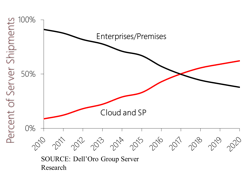Driving Next Generation Network Solutions at OIF – A Network Operator’s Perspective
Leading network operators, including cloud and internet content providers (CICPs) like Microsoft, actively participate in OIF to drive industry alignment on next-generation network solutions. In a time where there is a phenomenal increase in the adoption of cloud-based applications, there is a need for an organization that has the technical ability, process agility, and flexibility to address the requirements of the cloud.
Launched in 1998, OIF promotes the development and deployment of interoperable networking solutions and services through the creation of Implementation Agreements (IAs) for optical networking products, network processing elements, and component technologies. IAs are based on requirements developed cooperatively by end users, service providers, equipment vendors, and technology providers, and aligned with worldwide standards, augmented if necessary. (For more details on OIF and some of its ongoing projects, see “An OIF Overview.”)
Although not solely focused on the demands of the cloud market, OIF provides a technical forum with a flexible, member-driven process to provide time-to-market and broad ecosystem benefits. For companies like Microsoft, the ability to directly share market needs and provide technical input into OIF’s development process are critical factors in achieving industry alignment and enabling our next generation of data centers.
Sharing Requirements
There has been explosive growth of compute, storage, and network traffic by the CICPs. The graph below shows how, in just a short period of time, the volume of servers the CICPs have purchased has surpassed that of the traditional enterprise market. This growth is led by a much smaller number of companies than what composes the enterprise market; therefore, there is the ability for one company to have tremendous influence on the market.
While the CICPs may compete on services or offerings, it is well understood that, at the level of electrons and photons, no one is going to defy the laws of physics. If there is no way to break through these barriers, it is better to cooperate in the development of specifications.
By cooperating in the development of specifications, by openly sharing Microsoft’s requirements, we can bring a larger number of companies to the market to build solutions to meet our needs. In my opinion, this competition among the companies helps drive innovation, supply chain security, and lower costs.
Broad Industry Support
IAs, standards and specifications are critical in the development of broad industry support. Microsoft has the ability within OIF to share our requirements, as do other CICPs and network operator members of OIF. This permits members of OIF to work to develop a specification to meet the requirements.
One may think, “Why would you need to be involved if they know your requirements?” The key is that not all requirements are the same. Where Microsoft may only need a solution to satisfy a certain performance requirement, another may require the solution to exceed that requirement. Or, someone else may need additional requirements to be satisfied.
Microsoft could just toss their requirements “into the hat” and hope what results will satisfy. But by being engaged in OIF’s process, Microsoft can represent its requirements first-hand. Questions that may arise on those requirements can be answered in real-time. This helps to represent Microsoft’s requirements and commitment to OIF’s solution, which in turn leads to broader industry support for the development of a specification. Microsoft has been able to observe this with the 400ZR project.
Microsoft’s previous 100G solution for the same application was performed through an engagement with a single vendor. While this was necessary for Microsoft to develop its new network architecture, it was not what Microsoft wanted for our 400G network. In discussions with other CICPs, we discovered they had similar requirements and when we discussed where we thought to do the work, there was a broad agreement that OIF was the right organization due to its operating model and membership.
Exploration
One of the reasons OIF was felt to be the right organization was the ability to perform exploration prior to initiating a project. Other groups/standards bodies that were considered have a very rigid operating structure for how new projects can be explored or initiated. On the other hand, OIF has a very flexible structure that permits the ability to gain consensus and accelerate project initiation if there is broad agreement.
The 400ZR project is again a good example of OIF’s ability to accelerate to meet the market demand. At the OIF 4Q16 meeting in Auckland, New Zealand, a group of companies, led by Google and Microsoft, shared with OIF members the desire to start a future project for 400G coherent metro links. OIF members were in complete agreement on the need to develop a solution, and they accelerated the desire for a future project to become an active project.
At the OIF 2Q18 meeting in Nuremberg, Germany, there were requests to initiate two new projects under the Physical & Link Layer Working Group. The new project requests were closely related in trying to solve the same electrical challenge. Instead of having to either reject both or pick one, the OIF framework is flexible enough for the two parties to explore how to create a single project, which became CEI-112G-XSR, while at the same meeting, saving time and energy for those involved.
Exchange and Engagement
OIF has a format that permits members to exchange ideas and engage to develop solutions. As an end user, Microsoft is a member of the Network Operators Working Group (NetOp WG). The NetOp WG’s participation is open to all members of OIF, but only companies like Microsoft, Google, Alibaba, China Telecom, China Mobile, etc., are permitted to be voting members of the working group. This group permits end users to openly discuss ideas or where potential future IAs may need to be developed. While the voting members of NetOp WG may not have the same requirements and needs, the format of the group creates the ability to find areas where there is consensus or agreement.
All the working groups within OIF have a similar structure for open discussion and dialog. It is this flexibility in OIF working groups that permits the exchange of ideas and discovery of common challenges that need interoperable solutions. That exchange is fostered inside the working groups, and it also carries over into hallway and lunch conversations.
Networking
Networking is an aspect that can often be overlooked. It has been very important for Microsoft to be able to connect with existing and potential new vendors at OIF meetings. It gives us the ability to understand the ecosystem and learn where there may be dependencies for development of products we require or trends that could influence future development work.
Microsoft has used OIF to learn about or have early discussions with new vendors. It has provided us with the ability to discuss our ideas, our pain points, our concepts, and our needs. It is this sharing of information and knowledge that empowers others to create innovative ideas and concepts. And when those ideas and concepts become OIF IAs or are adopted by other standards bodies, then our industry benefits.
Summary
Participation in industry standards-setting organizations or forums is a decision that needs to be made by any company. For companies like Microsoft, our ability to directly share our market needs and technical input into the development process is important in making sure that the industry achieves alignment. Microsoft’s involvement in OIF has been relatively short, but we have seen positive impact in the ability to coordinate a common requirement across standards bodies and to initiate the development of specifications to enable our next generation of data centers.
Those interested in finding out more information, please see the following URL: www.oiforum.com.
Brad Booth is manager, network hardware engineering, Microsoft Azure Hardware Systems Group, at Microsoft. He is also president of the Consortium for On-Board Optics.
About the Author
Brad Booth
manager, network hardware engineering, Microsoft Azure Hardware Systems Group, Microsoft
Brad Booth is manager, network hardware engineering, Microsoft Azure Hardware Systems Group, at Microsoft. He is also president of the Consortium for On-Board Optics.

